Determining the Interaction of Social Sustainability with the Physical Environment: A Case Study of Adana, Turkey
Abstract
1. Introduction
- Is there a relationship between the concept of social sustainability and the physical formation of public spaces?
- To what extent are the parameters of social sustainability related to the physical environment of public spaces?
2. Literature Review
2.1. Social Sustainability and Its Interactions with the Physical Environment
2.2. Understanding the Social Aspect of Public Spaces
3. Materials and Methods
3.1. Case Context
3.2. Design and Data Collection
3.3. Determination and Explanation of Dimensions
3.4. Questionnaire Design
3.5. Demographic Description
4. Results
4.1. Determination of the Indicators
4.2. ANOVA for Identifying Regional Differences
4.3. Correlation between Social and Physical Factors
5. Discussion
6. Conclusions
Author Contributions
Funding
Institutional Review Board Statement
Informed Consent Statement
Data Availability Statement
Conflicts of Interest
References
- Bramley, G.; Power, S. Urban form and social sustainability: The role of density and housing type. Environ. Plan. B Plan. Des. 2009, 36, 30–48. [Google Scholar] [CrossRef]
- Rashidfarokhi, A.; Yrjänä, L.; Wallenius, M.; Toivonen, S.; Ekroos, A.; Viitanen, K. Social sustainability tool for assessing land use planning processes. Eur. Plan. Stud. 2018, 26, 1269–1296. [Google Scholar] [CrossRef]
- McKenzie, S. Social sustainability: Towards some definitions. In Working Paper Series, No: 27; Hawke Research Institute: Magill, Australia, 2004. [Google Scholar]
- Sachs, I. Social sustainability and whole development. In Sustainability and the Social Sciences; Becker, E., Jahn, T., Eds.; Zed Books and UNESCO: New York, NY, USA, 1999; pp. 25–36. [Google Scholar]
- Shirazi, M.R.; Keivani, R. The triad of social sustainability: Defining and measuring social sustainability of urban neighbourhoods. Urban Res. Pract. 2019, 12, 448–471. [Google Scholar] [CrossRef]
- Lotfata, A.; Ataöv, A. Urban streets and urban social sustainability: A case study on Bagdat street in Kadikoy, Istanbul. Eur. Plan. Stud. 2019, 28, 1735–1755. [Google Scholar] [CrossRef]
- Ročak, M.; Hospers, G.J.; Reverda, N. Searching for Social Sustainability: The Case of the Shrinking City of Heerlen, the Netherlands. Sustainability 2016, 8, 382. [Google Scholar] [CrossRef]
- Glasson, J.; Wood, G. Urban regeneration and impact assessment for social sustainability. Impact Assess. Proj. Apprais. 2009, 27, 283–290. [Google Scholar] [CrossRef]
- Colantino, A. Social sustainability: A review and critique of traditional versus emerging themes and assessment methods. In Proceedings of the Second International Conference on Whole Life Urban Sustainability and Its Assessment, Loughborough, UK, 22–24 April 2009; Malcolm, H., Price, A., Bebbington, J., Rohinton, E., Eds.; Loubhborough University: Loughborough, UK, 2009; pp. 865–885. [Google Scholar]
- Eizenberg, E.; Jabareen, Y. Social sustainability: A new conceptual framework. Sustainability 2017, 9, 68. [Google Scholar] [CrossRef]
- Davidson, M. Social sustainability: A potential for politics? Local Environ. 2009, 14, 607–619. [Google Scholar] [CrossRef]
- Weingaertner, C.; Moberg, A. Exploring Social Sustainability: Learning from Perspectives on Urban Development and Companies and Products. Sustain. Dev. 2014, 22, 122–133. [Google Scholar] [CrossRef]
- Vallance, S.; Perkins, H.C.; Dixon, J.E. What is social sustainability? A clarification of concepts. Geoforum 2011, 42, 342–348. [Google Scholar] [CrossRef]
- Ali, H.H.; Betawi, Y.N.; Qudah, H.S. Effects of urban form on social sustainability—A case study of Irbid. Jordan. Int. J. Urban Sustain. Dev. 2019, 11, 203–222. [Google Scholar] [CrossRef]
- Lefebvre, H. The Production of Space; Blackwell: Oxford, UK, 1992. [Google Scholar]
- Shirazi, M.R.; Keivani, R. Critical Reflections on the Theory and Practice of Social Sustainability in the Built Environment–A Meta-Analysis. Local Environ. 2017, 22, 1526–1545. [Google Scholar] [CrossRef]
- Goffman, E. Relations in Public: Microstudies of the Public Order; Basic Books: New York, NY, USA, 1971. [Google Scholar]
- Chiu, R.L.H. Socio-cultural sustainability of housing: A conceptual exploration. Hous. Theory Soc. 2004, 21, 65–76. [Google Scholar] [CrossRef]
- Ahman, H. Social sustainability—Society at the intersection of development and maintenance. Local Environ. 2013, 18, 1153–1166. [Google Scholar] [CrossRef]
- Stren, R.; Polese, M. Understanding the new sociocultural dynamics of cities: Comparative urban policy in a global context. In The Social Sustainability of Cities; Polese, M., Stren, R., Eds.; University of Toronto Press: Toronto, ON, Canada, 2000. [Google Scholar]
- Manzi, T.; Lucas, K.; Lloyd-Jones, T.; Allen, J. Understanding Social Sustainability: Key Concepts and Developments in Theory and Practice. In Social Sustainability in Urban Areas: Communities, Connectivity and the Urban Fabric; Manzi, T., Lucas, K., Lloyd-Jones, T., Allen, J., Eds.; Earthscan Publishing: London, UK, 2010. [Google Scholar]
- UK Presidency. The Bristol Accord: Conclusions of Ministerial Informal on Sustainable Communities in Europe; The Office of the Deputy Prime Minister: Ottawa, ON, Canada, 2005. [Google Scholar]
- Littig, B.; Grießler, E. Social Sustainability. A Catchword between Political Pragmatism and Social Theory. Int. J. Sustain. Dev. 2005, 8, 65–79. [Google Scholar] [CrossRef]
- Farhadikhah, H.; Ziari, K. Social sustainability between old and new neighborhoods, case study: Tehran neighborhoods. Environ. Dev. Sustain. 2020, 23, 2596–2613. [Google Scholar] [CrossRef]
- Cuthill, M. Strengthening the ‘social’ in sustainable development: Developing a conceptual framework for social sustainability in a rapid urban growth region in Australia. Sustain. Dev. 2010, 18, 362–373. [Google Scholar] [CrossRef]
- Grum, B.; Grum, D.K. Concepts of social sustainability based on social infrastructure and quality of life. Facilities 2020, 38, 783–800. [Google Scholar] [CrossRef]
- Goosen, Z.; Cilliers, E.J. Enhancing social sustainability through the planning of third places: A theory based framework. Soc. Indic. Res. 2020, 150, 835–866. [Google Scholar] [CrossRef]
- Chen, J.; Pellegrini, P.; Xu, Y.; Ma, G.; Wang, H.; An, Y.; Shi, Y.; Feng, X. Evaluating residents’ satisfaction before and after re-generation. The case of a high-density resettlement neighbourhood in Suzhou, China. Cogent Soc. Sci. 2022, 8, 2144137. [Google Scholar] [CrossRef]
- Chen, J.; Pellegrini, P.; Wang, H. Comparative Residents’ Satisfaction Evaluation for Socially Sustainable Regeneration—The Case of Two High-Density Communities in Suzhou. Land 2022, 11, 1483. [Google Scholar] [CrossRef]
- Izadi, A.; Mohammadi, M.; Nasekhian, S.; Memar, S. Structural Functionalism, Social Sustainability and the Historic Environment: A Role for Theory in Urban Regeneration. Hist. Environ. Policy Pract. 2020, 11, 158–180. [Google Scholar] [CrossRef]
- Landorf, C. Evaluating social sustainability in historic urban environments. Int. J. Herit. Stud. 2011, 17, 463–477. [Google Scholar] [CrossRef]
- Dempsey, N.; Brown, C.; Bramley, G. The key to sustainable urban development in UK cities? The influence of density on social sustainability. Prog. Plan. 2012, 77, 89–141. [Google Scholar] [CrossRef]
- Stender, M.; Walter, A. The role of social sustainability in building assessment. Build. Res. Inf. 2019, 47, 598–610. [Google Scholar] [CrossRef]
- Karuppannan, S.; Sivam, A. Social sustainability and neighbourhood design: An investigation of residents’ satisfaction in Delhi. Local Environ. 2011, 16, 849–870. [Google Scholar] [CrossRef]
- Chan, H.H.; Hu, T.; Fan, P. Social sustainability of urban regeneration led by industrial land redevelopment in Taiwan. Eur. Plan. Stud. 2019, 27, 1245–1269. [Google Scholar] [CrossRef]
- Ahmed, K.G. Urban social sustainability: A study of the Emirati local communities in Al Ain. Journal of Urbanism. Int. Res. Placemaking Urban Sustain. 2012, 5, 41–66. [Google Scholar] [CrossRef]
- Wan, L.; Ng, E. Evaluation of the social dimension of sustainability in the built environment in poor rural areas of China. Archit. Sci. Rev. 2018, 61, 319–326. [Google Scholar] [CrossRef]
- Søholt, S.; Ruud, M.E.; Braathen, E. A question of social sustainability: Urban interventions in critical neighbourhoods in Portugal and Norway. Urban Res. Pract. 2012, 5, 256–272. [Google Scholar] [CrossRef]
- Montgomery, J. Making a City: Urbanity, Vitality and Urban Design. J. Urban Des. 1998, 3, 93–116. [Google Scholar] [CrossRef]
- Marinkovic, A.; Vasilevska, L.; Miric, A.; Peric, D. Functional and design potential of city squares related to social sustainability. Tech. Technol. Educ. Manag. 2012, 7, 1446–1461. [Google Scholar]
- Carmona, M. The Place-shaping Continuum: A Theory of Urban Design Process. J. Urban Des. 2014, 19, 2–36. [Google Scholar] [CrossRef]
- Jacobs, J. The Death and Life of Great American Cities; Vintage Books: New York, NY, USA, 1961. [Google Scholar]
- Miao, P. Introduction. In Public Places in Asia Pacific Cities: Current Issues and Strategies; Springer: Berlin/Heidelberg, Germany, 2001; pp. 1–45. [Google Scholar]
- Iveson, K. Putting the public back into public space. Urban Policy Res. 1998, 16, 21–33. [Google Scholar] [CrossRef]
- Ozbek, M. Kamusal alanın sınırları. In Kamusal Alan; Özbek, M., Ed.; Hil Yayın: Istanbul, Turkey, 2004; pp. 19–90. [Google Scholar]
- Ruppert, E.S. Rights to public space: Regulatory reconfigurations of liberty. Urban Geogr. 2006, 27, 271–292. [Google Scholar] [CrossRef]
- Habermas, J. Strukturwandel der Öffentlichkeit; Hermann Luchterhand Verlag: Neuwied, Germany, 1962. [Google Scholar]
- Lee AY, L. Online news media in the Web 2.0 era: From boundary dissolution to journalistic transformation. Chin. J. Commun. 2012, 5, 210–226. [Google Scholar] [CrossRef]
- Arendt, H. The Human Condition; The University of Chicago Press: Chicago, IL, USA, 1998. [Google Scholar]
- Sennett, R. The Fall of Public Man; Alfred A. Knopf: New York, NY, USA, 1977. [Google Scholar]
- Schmidt, S.; Nemeth, J. Space, Place and the City: Emerging Research on Public Space Design and Planning. J. Urban Des. 2010, 15, 453–457. [Google Scholar] [CrossRef]
- Madanipour, A. Design of Urban Space: An Inquiry into a Socio-Spatial Process; John Wiley & Sons: Hoboken, NJ, USA, 1996. [Google Scholar]
- Mehta, V. Evaluating Public Space. J. Urban Des. 2014, 19, 53–88. [Google Scholar] [CrossRef]
- Carr, S.; Francis, M.; Rivlin, L.G.; Stone, A.M. Public Space; Cambridge University Press: Cambridge, UK, 1992. [Google Scholar]
- Smith, N.; Low, S. Introduction: The imperative of public space. In The Politics of Public Space; Low, S., Smith, N., Eds.; Taylor and Francis Group: Abingdon, UK, 2006; pp. 1–16. [Google Scholar]
- Carmona, M.; Magalhaes, C.; Hammond, L. Public Space: The Management Dimension; Routledge: London, UK, 2008. [Google Scholar]
- Turkish Statistical Institute-TUIK. 2021. Available online: https://www.tuik.gov.tr/ (accessed on 10 December 2021).
- Bodur Ün, M.; Paydak, A. Küreselleşen Dünyada Düzensiz Göç ve Türkiye: Adana İli Yabancılar Misafirhanesi Çalışması. Anadolu Üniversitesi Sos. Bilim. Derg. 2017, 17, 187–204. [Google Scholar] [CrossRef]
- Tülücü, T.A. The City of Adana’s Historical Industry Buildings Structural Analysis and a Study on Conservation Method (Publication No. 212652). Doctoral Dissertation, Gazi University, Ankara, Türkiye, 2007. [Google Scholar]
- Yılmaz, N. Konut Tasarım Sürecinde Kullanıcı Katılımı: Adana Kenti Bağlamında Bir Okuma (1960–1980). Master’s Thesis, Cukurova University, Institute of Natural and Applied Sciences, Adana, Türkiye, 2016. [Google Scholar]
- Reel, N.B. Analyse of the Evolution of Adana Tepebağ Tumulus and Its Environment in Historical Continum and Bringing This Region to Nowadays (Publication No. 182709). Master’s Thesis, Yildiz Technical University, İstanbul, Türkiye, 2006. [Google Scholar]
- Moghaddam, A. An Analysis on the Urban Tissue and Historic Buildings of Yarıyakup Urban Conservation Area in the City of Adana (Publication No. 307693). Master’s Thesis, Cukurova University, Adana, Türkiye, 2013. [Google Scholar]
- Erman, O.; Baş Yanarateş, D. Adana’da tarihi doku ve kentsel kimlik ilişkisi. In Adana Kentsel Kültür Envanteri; Durukan, İ., Karaman, F., Saban, D., Erman, O., Baş Yanarateş, D., Rmazanoğlu, G., Eds.; Adana Urban Culture Inventory; Ulusoy Ofset: Adana, Türkiye, 2012; pp. 37–38. [Google Scholar]
- Kim, H.Y. Statistical notes for clinical researchers: Assessing normal distribution (2) using skewness and kurtosis. Restor. Dent. Endod. 2013, 38, 52–54. [Google Scholar] [CrossRef]
- Hemani, S.; Das, A.K.; Chowdhury, A. Influence of urban forms on social sustainability: A case of Guwahati, Assam. Urban Des. Int. 2017, 22, 168–194. [Google Scholar] [CrossRef]
- Slavich, G.M.; Roos, L.G.; Zaki, J. Social belonging, compassion, and kindness: Key ingredients for fostering resilience, recovery, and growth from the COVID-19 pandemic. Anxiety Stress Coping 2021, 35, 1–8. [Google Scholar] [CrossRef] [PubMed]
- Lynch, K. The Image of the City; MIT Press: Cambridge, MA, USA, 1960. [Google Scholar]
- Tajfel, H.; Turner, J.C. An integrative theory of intergroup conflict. In The Social Psychology of Intergroup Relations; Austin, W.G., Worchel, S., Eds.; Brooks/Cole: Pacific Grove, CA, USA, 1979; pp. 33–37. [Google Scholar]
- Wagoner, J.A.; Belavadi, S.; Jung, J. Social identity uncertainty: Conceptualization, measurement, and construct validity. Self Identity 2017, 16, 505–530. [Google Scholar] [CrossRef]
- Kronenberg, J.; Haase, A.; Łaszkiewicz, E.; Antal, A.; Baravikova, A.; Biernacka, M.; Dushkova, D.; Filčak, R.; Haase, D.; Ignatieva, M.; et al. Environmental justice in the context of urban green space availability, accessibility, and attractiveness in postsocialist cities. Cities 2020, 106, 102862. [Google Scholar] [CrossRef]
- Larimian, T.; Freeman, C.; Palaiologou, F.; Sadeghi, N. Urban social sustainability at the neighbourhood scale: Measurement and the impact of physical and personal factors. Local Environ. 2020, 25, 747–764. [Google Scholar] [CrossRef]
- Collin, F. Social Reality; Routledge: London, UK, 2002. [Google Scholar]
- Khalili, A.; Fallah, S.N. Role of social indicators on vitality parameter to enhance the quality of women’s communal life within an urban public space (case: Isfahan’s traditional bazaar, Iran). Front. Archit. Res. 2018, 7, 440–454. [Google Scholar] [CrossRef]
- Low, S.; Altman, I. Place attachment: A conceptual inquiry. In Human Behavior and Environments: Advances in Theory and Research; Altman, I., ve Low, S., Eds.; Plenum Press: New York, NY, USA, 1992; Volume 12, pp. 1–12. [Google Scholar]
- Lopes, M.N.; Camanho, A.S. Public green space use and consequences on urban vitality: An assessment of European cities. Soc. Indic. Res. 2013, 113, 751–767. [Google Scholar] [CrossRef]
- World Bank. The Initiative on Defining, Monitoring and Measuring Social Capital (Working Paper 1); Social Capital Initiative; World Bank: Washington, DC, USA, 1998. [Google Scholar]
- Holman, N.; Rydin, Y. What can social capital tell us about planning under localism? Local Gov. Stud. 2013, 39, 71–88. [Google Scholar] [CrossRef]
- Matthies, A.L.; Kattilakoski, M.; Rantamäki, N. Citizens’ participation and community orientation—Indicators of social sustainability of rural welfare services. Nord. Soc. Work. Res. 2011, 1, 125–139. [Google Scholar] [CrossRef]
- McIntyre-Mills, J. Participatory Design for Democracy and Wellbeing: Narrowing the Gap Between Service Outcomes and Perceived Needs. Syst. Pract. Action Res. 2010, 23, 21–45. [Google Scholar] [CrossRef]
- Almahmoud, E.; Doloi, H.K. Identifying the key factors in construction projects that affect neighbourhood social sustainability. Facilities 2020, 38, 765–782. [Google Scholar] [CrossRef]
- Opp, S.M. The forgotten pillar: A definition for the measurement of social sustainability in American cities. Local Environ. 2017, 22, 286–305. [Google Scholar] [CrossRef]
- Friedkin, N.E. Social cohesion. Annu. Rev. Sociol. 2004, 30, 409–425. [Google Scholar] [CrossRef]
- Dempsey, N.; Bramley, G.; Power, S.; Brown, C. The social dimension of sustainable development: Defining urban social sustainability. Sustain. Dev. 2011, 19, 289–300. [Google Scholar] [CrossRef]
- Ballet, J.; Bazin, D.; Mahieu, F.R. A policy framework for social sustainability: Social cohesion, equity and safety. Sustain. Dev. 2020, 28, 1388–1394. [Google Scholar] [CrossRef]
- Portes, A.; Landolt, P. The Downside of Social Capital. Am. Prospect. 1996, 26, 18–21. [Google Scholar] [CrossRef] [PubMed]
- European Commission. Accompanying Document to the Progress Report on the European Union Sustainable Development Strategy 2007 (SEC 2007 1416). Commission Staff Working Document. 2007. Available online: https://eur-lex.europa.eu/legal-content/EN/ALL/?uri=CELEX%3A52007SC1416 (accessed on 10 December 2022).
- Hussain, M.; Ajmal, M.M.; Gunasekaran, A.; Khan, M. Exploration of social sustainability in healthcare supply chain. J. Clean. Prod. 2018, 203, 977–989. [Google Scholar] [CrossRef]
- Olsen, S.J.; Azziz-Baumgartner, E.; Budd, A.P.; Brammer, L.; Sullivan, S.; Pineda, R.F.; Cohen, C.; Fry, A.M. Decreased Influenza Activity During the COVID-19 Pandemic—United States, Australia, Chile, and South Africa. MMWR Morb. Mortal. Wkly. Rep. 2020, 69, 1305–1309. [Google Scholar] [CrossRef]
- Barton, H. Conflicting perceptions of neighbourhood. In Sustainable Communities: The Potential for Eco–Neighbourhoods; Barton, H., Ed.; Earthscan: London, UK, 2000; pp. 3–18. [Google Scholar]
- Crabtree, A.; Gasper, D. Conclusion: The sustainable development goals and capability and human security analysis. In Sustainability, Capabilities and Human Security; Crabtree, A., Ed.; Palgrave Macmillan: London, UK, 2020; pp. 169–182. [Google Scholar] [CrossRef]
- Shaftoe, H. Community safety and actual neighbourhoods. In Sustainable Communities: The Potential for Eco–Neighbourhoods; Barton, H., Ed.; Earthscan: London, UK, 2000; pp. 230–243. [Google Scholar]
- Dave, S. Neighbourhood density and social sustainability in cities of developing countries. Sustain. Dev. 2011, 19, 189–205. [Google Scholar] [CrossRef]
- Charkhchian, M.; Daneshpour, S.A. Introduction to multiple dimensions of responsive public space: A case study in Iran. Prostor 2010, 18, 218–227. [Google Scholar]
- Low, S.; Taplin, D.; Scheld, S. Rethinking Urban Parks: Public Space and Cultural Diversity; The University of Texas Press: Austin, TA, USA, 2005. [Google Scholar]
- Grum, B.; Temeljotov Salaj, A. The comparison of expressed satisfaction and expectations of potential real estate buyers in Slovenia and Japan. Facilities 2013, 31, 6–23. [Google Scholar] [CrossRef]
- Wai SHYusof AHai, T.; Ismail, S. A conceptual review of social infrastructure projects. Commun. IBIMA 2012, 2012, 222039. [Google Scholar] [CrossRef]
- Praliya, S.; Garg, P. Public space quality evaluation: Prerequisite for public space management. J. Public Space 2019, 4, 93–126. [Google Scholar] [CrossRef]
- Duheime, G.; Searles, E.; Usher, P.J.; Myers, H.; Frechette, P. Social cohesion and living conditions in the Canadian Arctic: From theory to measurement. Soc. Indic. Res. 2002, 66, 295–317. [Google Scholar] [CrossRef]
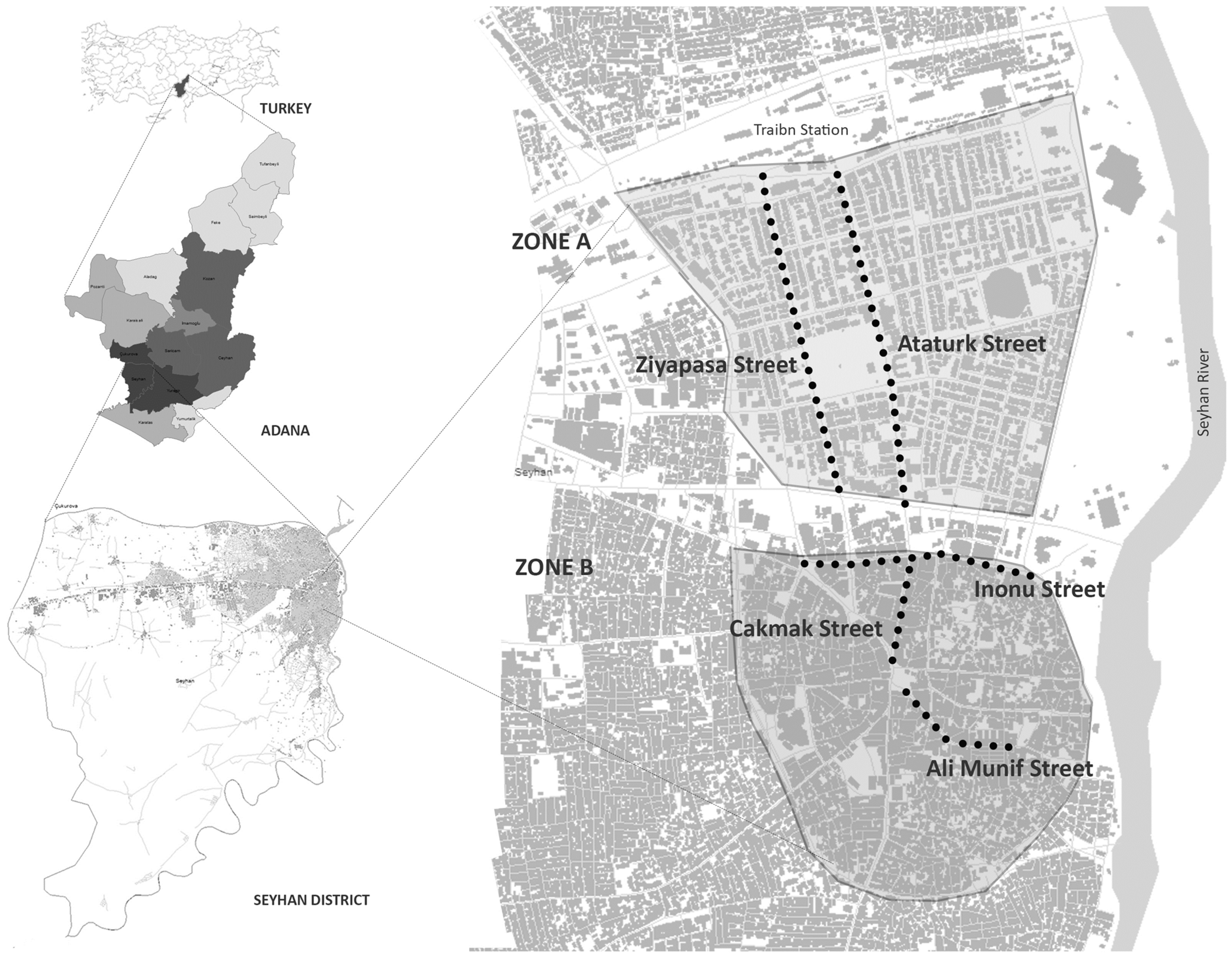
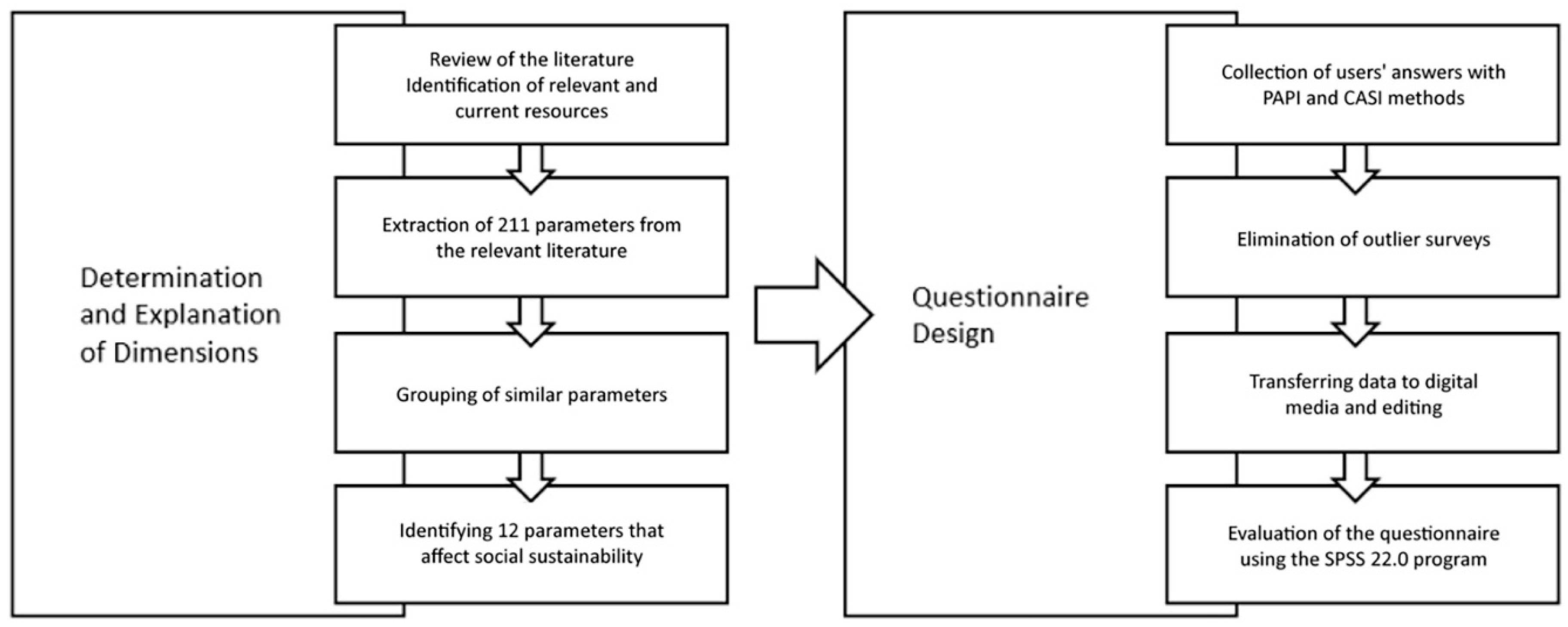
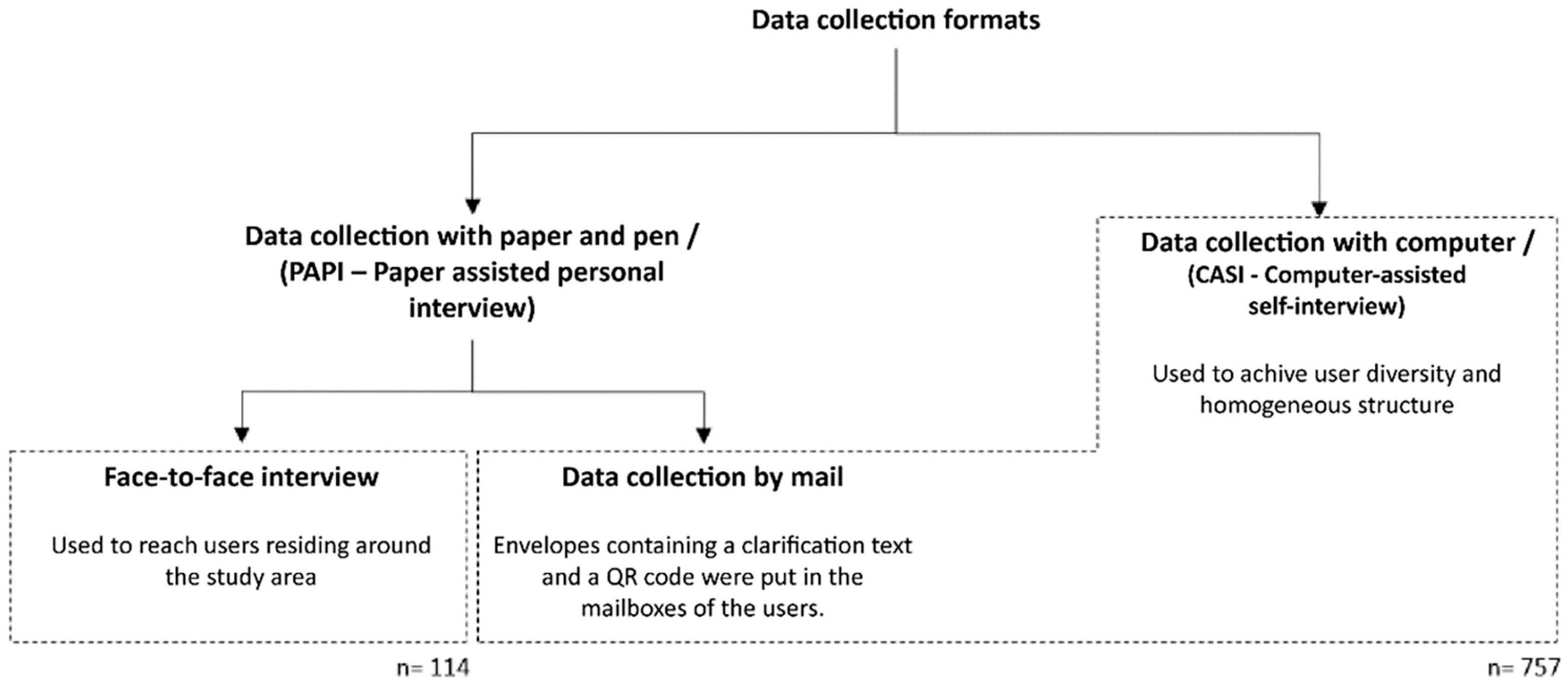
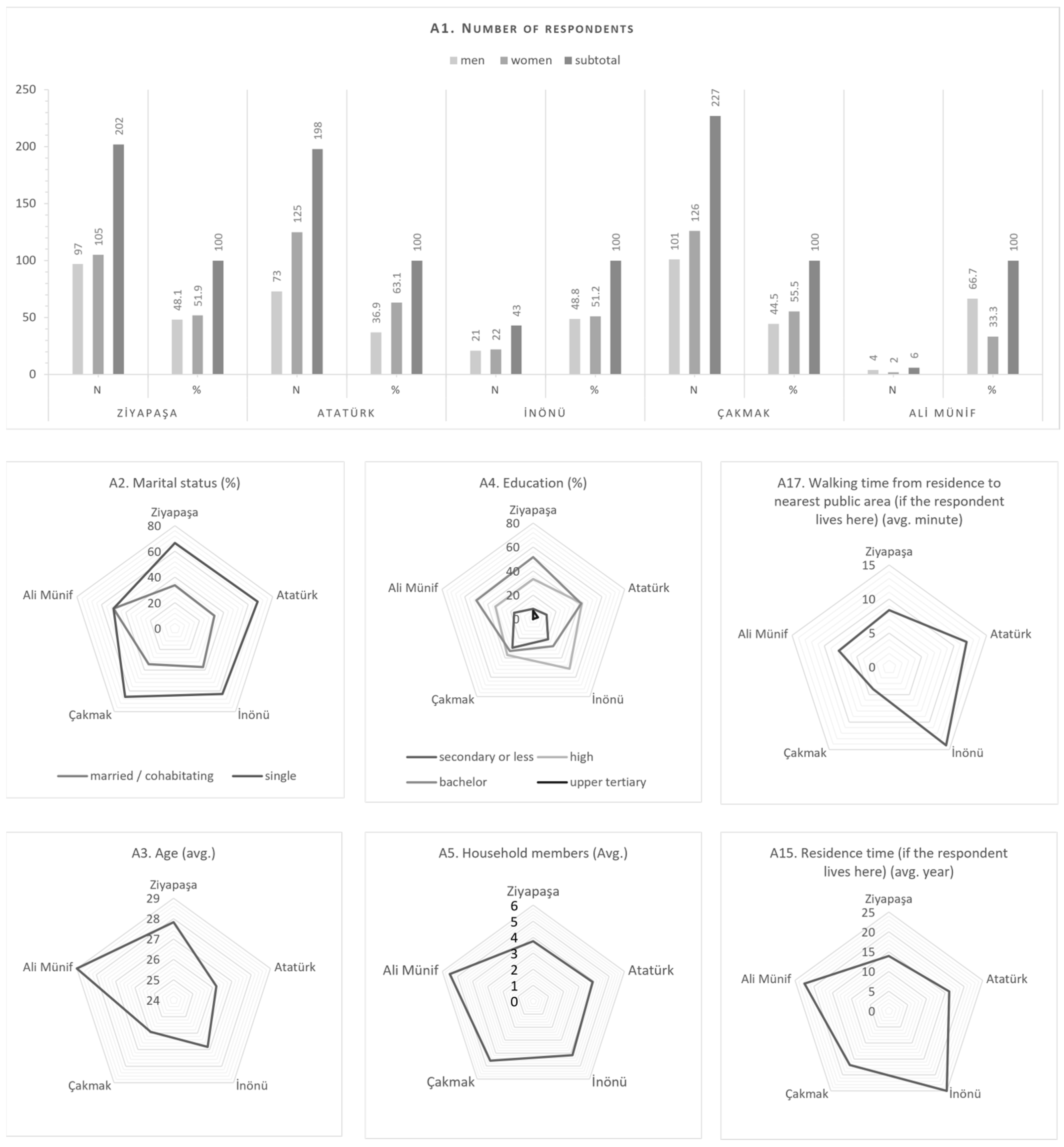
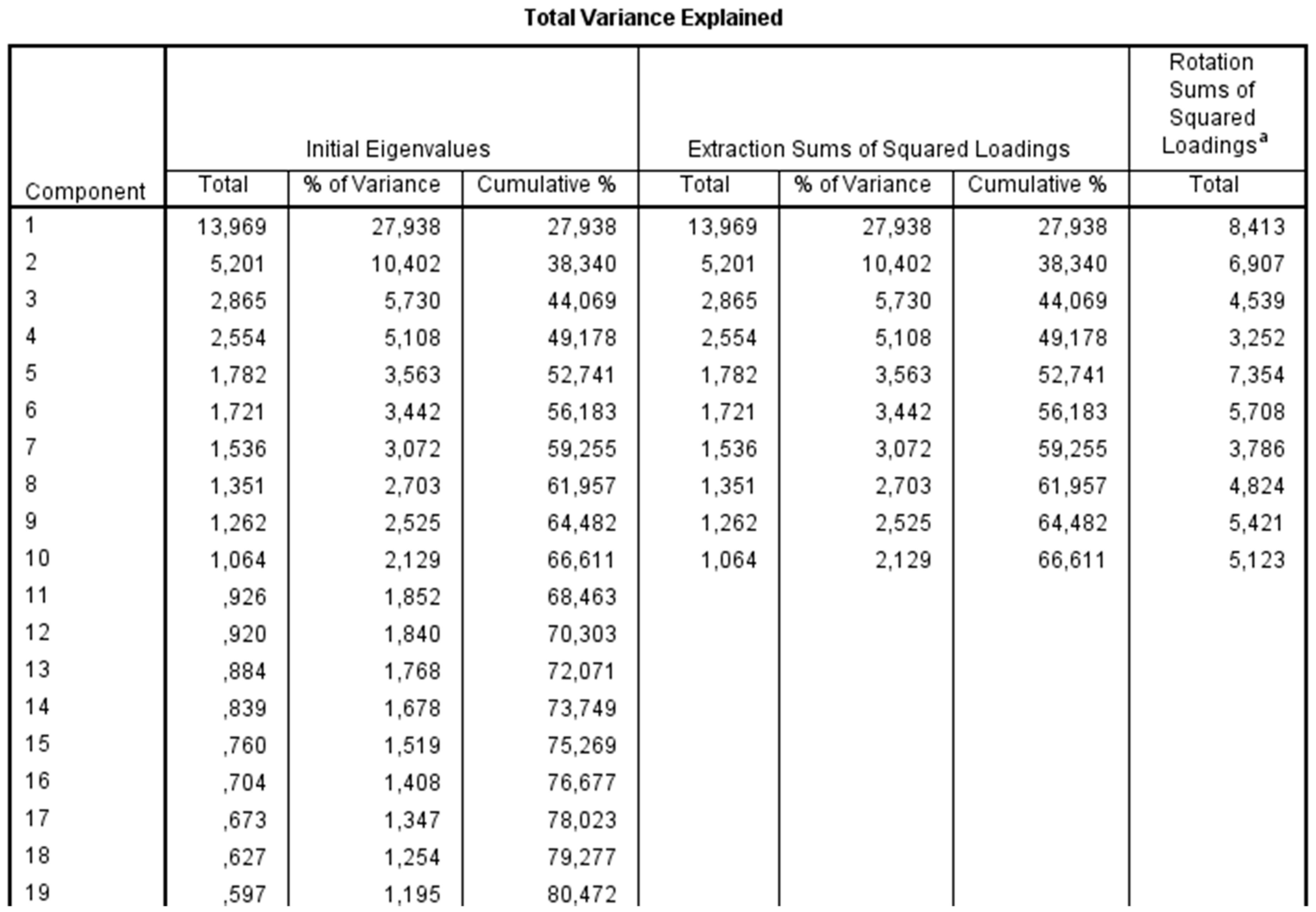
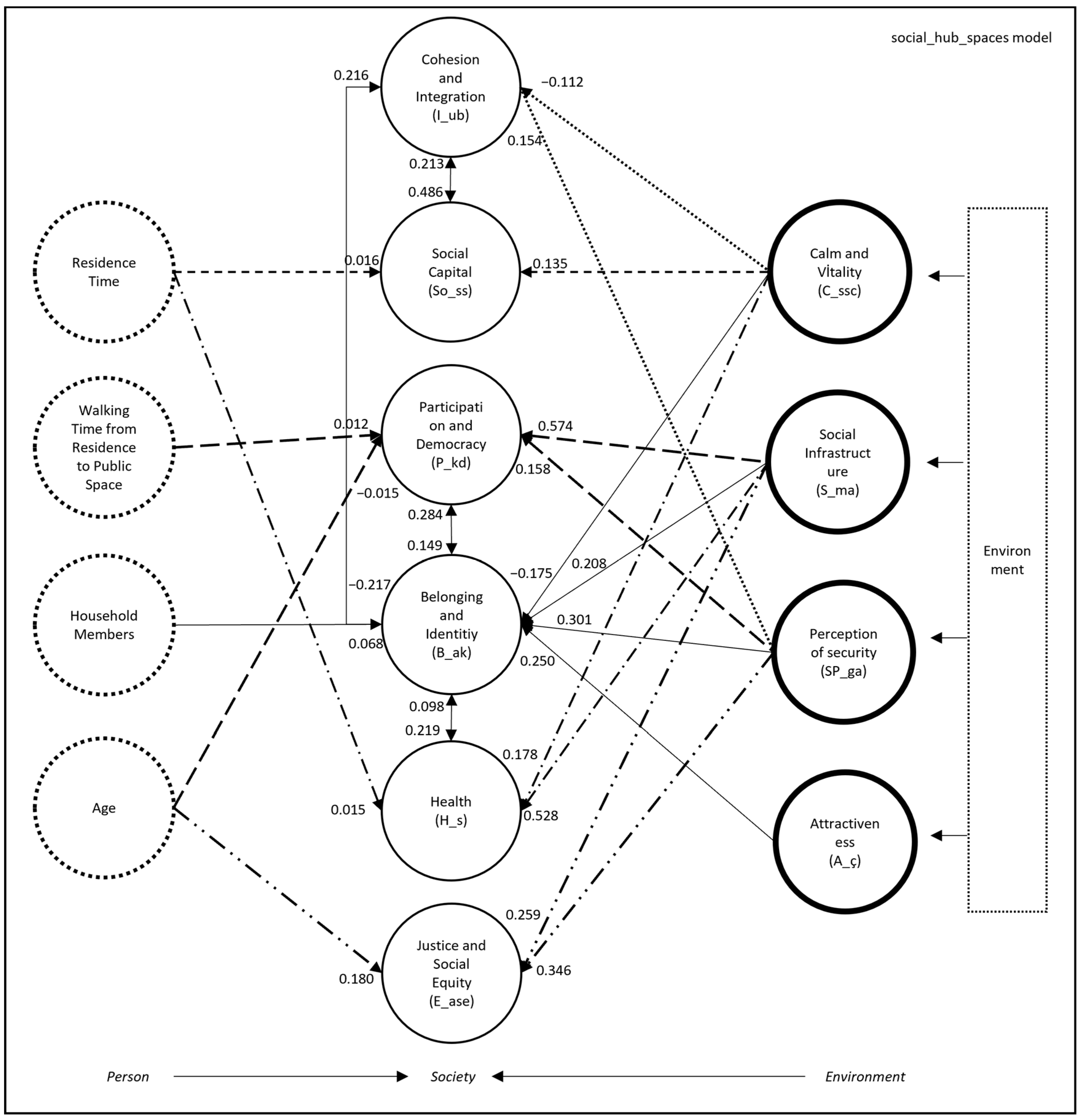
| Dimension | Variables | Definition |
|---|---|---|
| B. Justice and Social Equity | 1. Equal benefit from public services 2. Equal benefit in activities 3. Gender equality 4. Financial necessity | Equal access to all resources without any criteria. |
| C. Cohesion and Integration | 1. Responsibility towards people and the environment 2. Helping those in need 3. Tolerance 4. Empathy 5. A sense of solidarity 6. Conditions for the formation of unity and solidarity | Existence of common consciousness, responsibility, trust, and integrity in society. |
| D. Social Network and Social Capital | 1. Encounters with acquaintances 2. Familiarity 3. Recognition in the environment 4. Enjoying spending time 5. The effect of familiarity on daily life | Individuals creating networks that increase happiness and quality of life in society. |
| E. Security | 1. Sense of security during the daytime 2. Sense of security at night 3. Adequacy of security measures 4. Feeling free | The adequacy of the elements that ensure society’s security and the sum of the consequent feelings it creates in individuals. |
| F. Social Infrastructure and Activities | 1. Activities benefited 2. Type of transportation 3. Adequacy of public transport 4. Adequacy of activity 5. Adequacy of parking space 6. Vehicle traffic 7. Adequacy of open space | The physical spaces and activities required for the formation of social connections and capital. |
| G. Participation and Democracy | 1. Being able to express ideas without hesitation 2. Cooperation with local government 3. Feeling valued in decision-making processes | Participatory approach to management processes and activity arrangements. |
| H. Governance and Property Acquisition | 1. Regulation adequacy 2. Adequacy in acquiring knowledge 3. Stability in management 4. Adequacy of financial power to acquire property | Existence of transparency, institutional stability, and flexibility in local governments |
| I. Inclusion and Diversity | 1. Freedom of movement for the elderly and disabled 2. Discrimination 3. Human diversity | Everyone benefiting from spatial and social activities, and human diversity is ensured in a heterogeneous society. |
| J. Social Stability and Cohesion | 1. Enjoying spending time 2. The desire to live in the environment for a long time 3. Commitment 4. Sense of belonging | Desire to live in the region for a long time and a sense of commitment and belonging to that region |
| K. Identity and Cultural Heritage | 1. Identity of the environment 2. Being unique 3. Perception of the environment 3(1). Perception of attractiveness 3(2). Perception of easy accessibility 3(3). Perception of being well connected 3(4). Perception of being in the center 3(5). Perception of holism 3(6). Perception of accessibility 3(7). Perception of familiarity 3(8). Perception of foliage 3(9). Perception of sound 3(10). Perception of calmness 3(11). Perception of permanence 3(12). Perception of cleanliness 3(13). Perception of traffic 3(14). Perception of beauty 3(15). Perception of smell | The region having its own and unique identity. |
| L. Legibility | 1. Easy navigation 2. Getting lost | Ease of mental processing in an urban space |
| M. Imageability | 1. Meeting points 2. Points of attraction | The quality of visualization and image construction in an urban space. |
| N. Quality of Environmental Structures | 1. Perception of orderly structure 2. Facade | The quality of the physical environment lived in |
| O. Health | 1. Social use of streets during the pandemic 2. Concern about street use during the pandemic 3. The effect of the pandemic on the way of life 4. Interacting with people during the pandemic 5. Desire to be in open spaces 6. Garbage collection 7. Cleaning satisfaction | The effect of various diseases, cleaning orders, and elements that affect the environment, such as garbage, on the individual. |
| Kaiser-Meyer-Olkin Measure of Sampling Adequacy. | 0.926 | |
| Bartlett’s Test of Sphericity | Approx. Chi-Square | 21,552.922 |
| df | 1225 | |
| Sig. | 0.000 | |
| 1 | 2 | 3 | 4 | 5 | 6 | 7 | 8 | 9 | 10 | ||
|---|---|---|---|---|---|---|---|---|---|---|---|
| Belonging and Identity (B_ak) | J4. I feel like I belong to the square/street in this neighborhood. | 0.750 | |||||||||
| K2. The unique stance of the square/street in this neighborhood makes this place attractive to me. | 0.728 | ||||||||||
| J1. I enjoy spending a long time in this neighborhood. | 0.705 | ||||||||||
| J3. I feel connected to the square/street in this neighborhood. | 0.686 | ||||||||||
| K1. I think that the square/street in this neighborhood has its own identity. | 0.661 | ||||||||||
| J2. I would like to live in this neighborhood for a long time. | 0.622 | ||||||||||
| D4. I enjoy spending time with my acquaintances in this neighborhood. | 0.548 | ||||||||||
| F4. I find activities sufficient to spend time with my acquaintances in this neighborhood. | 0.449 | ||||||||||
| I3. I am happy with the diversity and heterogeneity of the people in this neighborhood. | 0.417 | ||||||||||
| Attractiveness (A_c) | K3. [Easily accessible] | 0.957 | |||||||||
| K3. [Close by] | 0.920 | ||||||||||
| K3. [Memorable] | 0.910 | ||||||||||
| K3. [Attractive] | 0.822 | ||||||||||
| K3. [Nice looking] | 0.758 | ||||||||||
| K3. [Clean] | 0.701 | ||||||||||
| K3. [Green] | 0.684 | ||||||||||
| K3. [Fragrant] | 0.627 | ||||||||||
| Calm and Vitality (C_ssc) | K3. [Silent] | 0.904 | |||||||||
| K3. [Calm] | 0.865 | ||||||||||
| K3. [Low traffic] | 0.833 | ||||||||||
| Social Capital (So_ss) | D2. People in this neighborhood know each other. | 0.828 | |||||||||
| D3. People in this street recognize me. | 0.815 | ||||||||||
| D1. I come across familiar people all the time in this neighborhood. | 0.707 | ||||||||||
| D5. The people I know in this neighborhood make my daily life easier. | 0.530 | ||||||||||
| Participation and Democracy (P_kd) | G2. I can cooperate and share ideas with local governments about this square/street. | 0.877 | |||||||||
| G3. In this neighborhood, I feel that my opinion is valued in decision-making processes. | 0.850 | ||||||||||
| G1. In this neighborhood, I freely express my ideas in the processes of renewal, change, and transformation. | 0.739 | ||||||||||
| H3. I think that stability has been achieved in the management of this neighborhood. | 0.555 | ||||||||||
| H2. I can get adequate information about the square/street from the local administration covering this neighborhood. | 0.551 | ||||||||||
| Justice and Social Equity (E_ase) | B1. In this neighborhood, I can benefit from public institutions and organizations on an equal basis with everyone. | 0.876 | |||||||||
| B2. I can benefit from the activities in this neighborhood equally with everyone. | 0.851 | ||||||||||
| B3. There is gender equality in this neighborhood. | 0.645 | ||||||||||
| B4. I do not need money to spend time in this neighborhood. | 0.467 | ||||||||||
| Cohesion and Integration (I_ub) | C3. I am tolerant of people in this neighborhood. | 0.852 | |||||||||
| C2. I help the elderly and disabled in this neighborhood. | 0.844 | ||||||||||
| C4. I see understanding from people in this neighborhood. | 0.437 | ||||||||||
| C5. There is a sense of solidarity among people in this neighborhood. | 0.416 | ||||||||||
| Health (H_s) | O3. The pandemic has not changed the way I use this square/street. | 0.842 | |||||||||
| O2. I used this square/street without hesitation during the pandemic. | 0.749 | ||||||||||
| O1. I used this square/street as a social place during the pandemic. | 0.730 | ||||||||||
| Security Perception (SP_ga) | E2. I feel safe on this street at night. | −0.776 | |||||||||
| E3. The security measures in this neighborhood are sufficient. | −0.657 | ||||||||||
| E4. I feel free in this square/street. | −0.650 | ||||||||||
| E1. I feel safe on this street during daylight hours. | −0.601 | ||||||||||
| Social infrastructure (S_mc) | N1. I find the structures around this square/street orderly. | −0.700 | |||||||||
| N2. I like the facades of the buildings around this square/street. | −0.638 | ||||||||||
| F5. I find the car parking areas sufficient in this neighborhood. | −0.592 | ||||||||||
| I1. The elderly and the disabled (mentally or physically) can move freely in this neighborhood. | −0.436 | ||||||||||
| F7. I find the open spaces for socializing sufficient in this neighborhood. | −0.375 | ||||||||||
| F6. Vehicle traffic in this neighborhood bothers me. | 0.316 |
| No | Number of Items | Cronbach’s Alpha Coefficient |
|---|---|---|
| 1 | 9 | 0.903 |
| 2 | 8 | 0.943 |
| 3 | 3 | 0.892 |
| 4 | 4 | 0.778 |
| 5 | 5 | 0.771 |
| 6 | 4 | 0.715 |
| 7 | 4 | 0.687 |
| 8 | 3 | 0.773 |
| 9 | 4 | 0.832 |
| 10 | 6 | 0.864 |
| Coefficient calculated for all questions: | 0.943 | |
| Between Groups | Sum of Squares | df | Mean Square | F | Sig. |
|---|---|---|---|---|---|
| Belonging and identity (B_ak) | 55.645 | 4 | 13.911 | 17.247 | 0.000 * |
| Social capital (So_ss) | 7.937 | 4 | 1.984 | 2.204 | 0.067 |
| Participation and democracy (P_kd) | 29.050 | 4 | 7.263 | 6.586 | 0.000 * |
| Justice and Social Equity (E_ase) | 39.471 | 4 | 9.868 | 11.352 | 0.000 * |
| Cohesion and Integration (I_ub) | 21.436 | 4 | 5.359 | 13.863 | 0.000 * |
| Health (H_s) | 40.195 | 4 | 10.049 | 7.445 | 0.000 * |
| Mean Difference (I–J) | Std. Error | Sig. | |||
|---|---|---|---|---|---|
| Ziyapaşa | Cakmak | 0.68386 * | 0.08402 | 0.000 | |
| Belonging and identity (B_ak) | Ataturk | Cakmak | 0.51945 * | 0.08945 | 0.000 |
| Cakmak | Ziyapasa Ataturk | −0.68386 * | 0.08402 | 0.000 | |
| −0.51945 * | 0.08945 | 0.000 | |||
| Social capital (So_ss) | - | - | - | - | - |
| Participation and democracy (P_kd) | Ziyapaşa | Cakmak | 0.44964 * | 0.10241 | 0.000 |
| Ataturk | Cakmak | 0.43806 * | 0.10086 | 0.000 | |
| Cakmak | Ziyapasa Ataturk | −0.44964 * | 0.10241 | 0.000 | |
| −0.43806 * | 0.10086 | 0.000 | |||
| Justice and Social Equity (E_ase) | Ziyapaşa | Cakmak | 0.52511 * | 0.09008 | 0.000 |
| Ataturk | Cakmak | 0.49007 * | 0.09202 | 0.000 | |
| Cakmak | Ziyapasa Ataturk Inonu | −0.52511 * | 0.09008 | 0.000 | |
| −0.49007 * | 0.09202 | 0.000 | |||
| −0.41225 * | 0.14675 | 0.050 | |||
| Inonu | Cakmak | 0.41225 * | 0.14675 | 0.050 | |
| Cohesion and Integration (I_ub) | Ziyapasa | Cakmak Inonu | 0.37162 * | 0.06087 | 0.000 |
| 0.32803 * | 0.11205 | 0.038 | |||
| Ataturk | Cakmak Inonu | 0.36166 * | 0.06145 | 0.000 | |
| 0.31806 * | 0.11237 | 0.049 | |||
| Cakmak | Ziyapasa Ataturk | −0.37162 * | 0.06087 | 0.000 | |
| −0.36166 * | 0.06145 | 0.000 | |||
| Inonu | Zıyapasa Ataturk | −0.32803 * | 0.11205 | 0.038 | |
| −0.31806 * | 0.11237 | 0.049 | |||
| Health (H_s) | Ziyapasa | Cakmak | 0.56320 * | 0.11346 | 0.000 |
| Ataturk | Cakmak | 0.47291 * | 0.11159 | 0.000 | |
| Cakmak | Ziyapasa Ataturk | −0.56320 * | 0.11346 | 0.000 | |
| −0.47291 * | 0.11159 | 0.000 | |||
| Model 8 R: 0.835; R2: 0.697; Adj. R2: 0.610; Std. Err.: 0.57087; R2 Change: 0.009; ANOVA: F: 56.243; p (sig.): 0.000 | ||||
| Model | B | Std. Error | ß | Sig. |
| (Constant) | 0.335 | 0.295 | 0.258 | |
| SP_ga | 0.301 | 0.050 | 0.326 | 0.000 |
| A_ç | 0.250 | 0.042 | 0.288 | 0.000 |
| I_ub | 0.217 | 0.067 | 0.151 | 0.001 |
| C_ssc | −0.175 | 0.052 | −0.168 | 0.001 |
| S_mç | 0.208 | 0.065 | 0.197 | 0.002 |
| P_kd | 0.149 | 0.053 | 0.168 | 0.005 |
| A5 | −0.068 | 0.024 | −0.113 | 0.005 |
| H_s | 0.098 | 0.042 | 0.116 | 0.020 |
| Model 3 R: 0.478; R2: 0.229; Adj. R2: 0.217; Std. Err.: 0.76398; R2 Change: 0.023; ANOVA: F: 19.876; p (sig.): 0.000 | ||||
| Model | B | Std. Error | ß | Sig. |
| (Constant) | 1,361 | 0.358 | 0.000 | |
| I_ub | 0.486 | 0.076 | 0.397 | 0.000 |
| A15 | 0.016 | 0.005 | 0.214 | 0.001 |
| C_ssc | 0.135 | 0.055 | 0.153 | 0.015 |
| Model 5 R: 0.769; R2: 0.592; Adj. R2: 0.582; Std. Err.: 0.74156; R2 Change: 0.009; ANOVA: F: 57.720; p (sig.): 0.000 | ||||
| Model | B | Std. Error | ß | Sig. |
| (Constant) | 0.061 | 0.302 | 0.839 | |
| S_mç | 0.574 | 0.074 | 0.482 | 0.000 |
| B_ak | 0.284 | 0.079 | 0.252 | 0.000 |
| SP_ga | 0.158 | 0.066 | 0.151 | 0.018 |
| A17 | 0.012 | 0.006 | 0.101 | 0.031 |
| A3 | −0.015 | 0.007 | −0.097 | 0.036 |
| Model 3 R: 0.586; R2: 0.343; Adj. R2: 0.333; Std. Err.: 0.82190; R2 Change: 0.018; ANOVA: F: 34.996; p (sig.): 0.000 | ||||
| Model | B | Std. Error | ß | Sig. |
| (Constant) | 0.803 | 0.296 | 0.007 | |
| SP_ga | 0.346 | 0.064 | 0.378 | 0.000 |
| S_mç | 0.259 | 0.073 | 0.248 | 0.000 |
| A3 | 0.018 | 0.008 | 0.135 | 0.020 |
| Model 4 R: 0.620; R2: 0.384; Adj. R2: 0.372; Std. Err.: 0.55869; R2 Change: 0.022; ANOVA: F: 31.216; p (sig.): 0.000 | ||||
| Model | B | Std. Error | ß | Sig. |
| (Constant) | 2.314 | 0.214 | 0.000 | |
| B_ak | 0.216 | 0.053 | 0.311 | 0.000 |
| So_ss | 0.213 | 0.048 | 0.261 | 0.000 |
| SP_ga | 0.154 | 0.050 | 0.239 | 0.002 |
| C_ssc | −0.112 | 0.042 | −0.156 | 0.008 |
| Model 5 R: 0.626; R2: 0.392; Adj. R2: 0.377; Std. Err.: 0.095699; R2 Change: 0.012; ANOVA: F: 25.643; p (sig.): 0.000 | ||||
| Model | B | Std. Error | ß | Sig. |
| (Constant) | 0.034 | 0.304 | 0.912 | |
| S_mç | 0.498 | 0.095 | 0.396 | 0.000 |
| C_ssc | 0.273 | 0.085 | 0.220 | 0.002 |
| B_ak | 0.284 | 0.094 | 0.238 | 0.003 |
| A15 | 0.016 | 0.006 | 0.146 | 0.010 |
| A_c | −0.150 | 0.074 | −0.145 | 0.045 |
Disclaimer/Publisher’s Note: The statements, opinions and data contained in all publications are solely those of the individual author(s) and contributor(s) and not of MDPI and/or the editor(s). MDPI and/or the editor(s) disclaim responsibility for any injury to people or property resulting from any ideas, methods, instructions or products referred to in the content. |
© 2024 by the authors. Licensee MDPI, Basel, Switzerland. This article is an open access article distributed under the terms and conditions of the Creative Commons Attribution (CC BY) license (https://creativecommons.org/licenses/by/4.0/).
Share and Cite
Acik Etike, B.; Erdonmez Dincer, M.E. Determining the Interaction of Social Sustainability with the Physical Environment: A Case Study of Adana, Turkey. Sustainability 2024, 16, 4947. https://doi.org/10.3390/su16124947
Acik Etike B, Erdonmez Dincer ME. Determining the Interaction of Social Sustainability with the Physical Environment: A Case Study of Adana, Turkey. Sustainability. 2024; 16(12):4947. https://doi.org/10.3390/su16124947
Chicago/Turabian StyleAcik Etike, Buse, and Muyesser Ebru Erdonmez Dincer. 2024. "Determining the Interaction of Social Sustainability with the Physical Environment: A Case Study of Adana, Turkey" Sustainability 16, no. 12: 4947. https://doi.org/10.3390/su16124947
APA StyleAcik Etike, B., & Erdonmez Dincer, M. E. (2024). Determining the Interaction of Social Sustainability with the Physical Environment: A Case Study of Adana, Turkey. Sustainability, 16(12), 4947. https://doi.org/10.3390/su16124947







